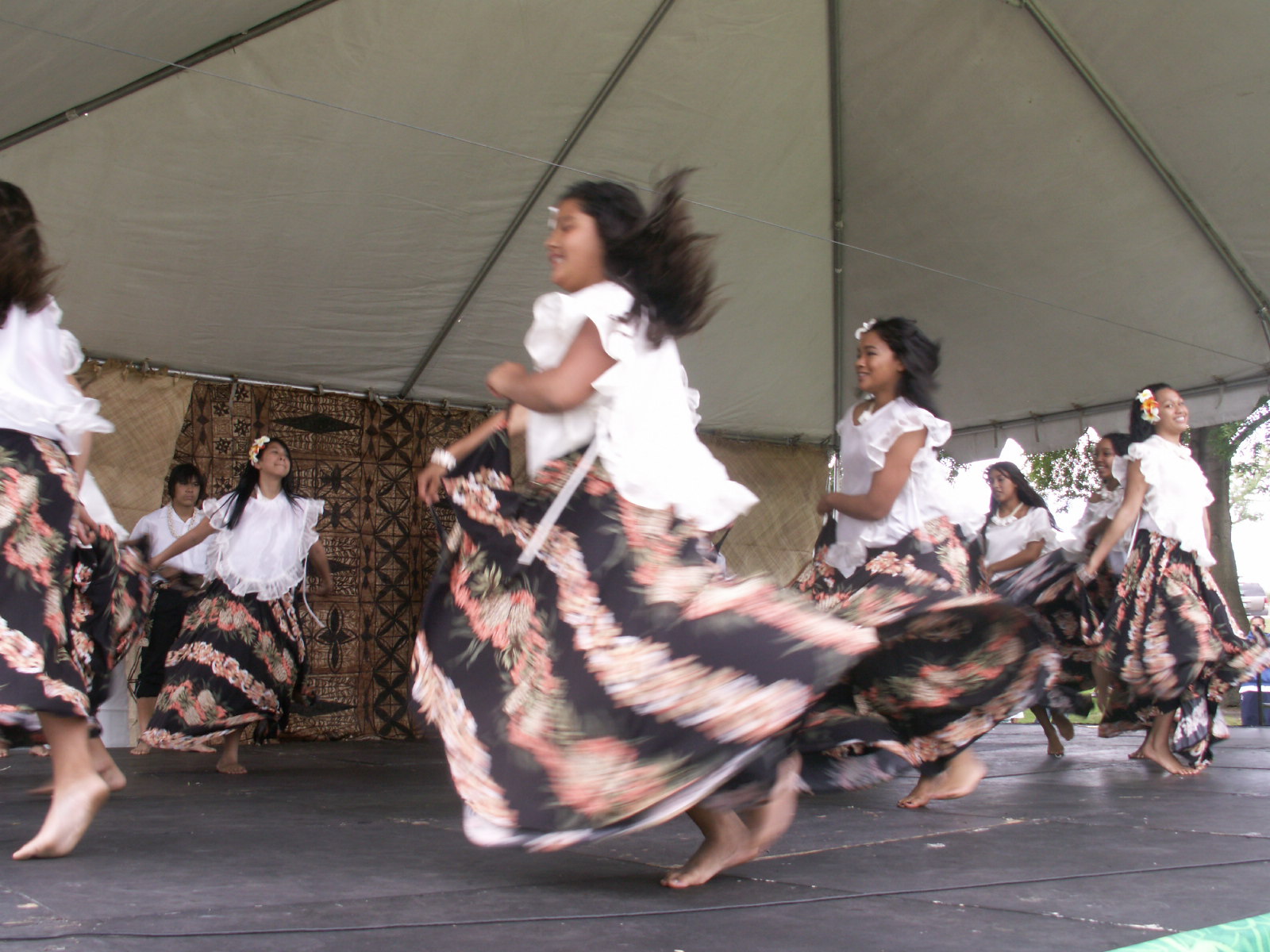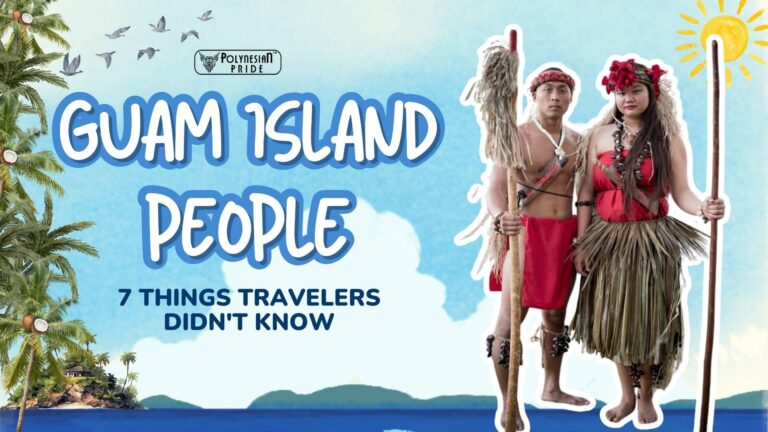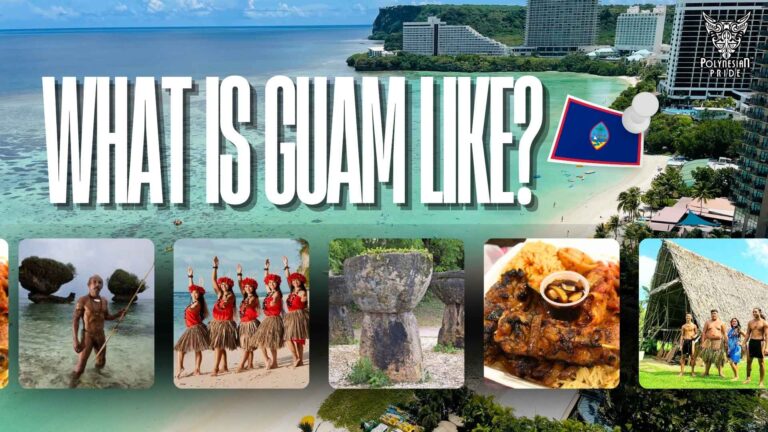Discover Guam Cultural Dance: Honoring Chamorro’s Heritage

Guam, a picturesque island in the Pacific Ocean, boasts a rich cultural heritage, with dance playing a crucial role in preserving and celebrating its history. The Chamorro people, indigenous to Guam, have passed down their vibrant dance traditions for generations, providing a glimpse into their ancient customs, beliefs, and stories.
This article explores the fascinating world of Guam cultural dance, delving into its origins, styles, costumes, music, and significance in Guam culture.
The Origin of the Guam Cultural Dance
The Guam Cultural Dance, also called the Chamorro Dance, has deep roots and vibrant evolution and tells the rich history of Guam’s Indigenous people.
Early Descriptions of Chamorro Dance
In the early days, visitors to the Mariana Islands provided only vague descriptions of the native Chamorro dance. A Jesuit report from 1669-1670 offers a rare glimpse into a women’s dance where twelve or thirteen women swayed in place, rhythmically moving their hands. They held half-moons in their right hands and small boxes of shells and bells in their left, creating a pleasing rhythm. Accompanied by three-part harmony singing led by a man in tenor voice, their songs narrated their history and genealogies.
The description also highlighted their attire: fragrant flowers on their foreheads, strings of red shells (possibly Spondylus) adorned with trinkets, and skirts made from tree roots and small coconuts. These skirts resembled a birdcage, revealing rather than concealing their bodies.

Evolution of Chamorro Dance
When French explorer Louis Claude de Freycinet visited in 1819, indigenous Chamorro dance had started incorporating Spanish influences. Freycinet’s account mentions a native dance performed during great feasts, with men and women alternating in a circle, singing praises to the person honored in the center. However, Spanish dances had already begun to overshadow indigenous traditions. At that time, the Spanish governor organized celebrations featuring “dances of Montezuma” from Mexico, with dancers in colorful silk and satin costumes. Additionally, children in Hagåtña entertained visitors by dancing around a sombrero, showcasing a blend of local and Spanish influences.

Guam Cultural Dance Through the Ages
Spanish and American Influences
Oral histories from the early 1900s recall dances introduced during the Spanish Colonial Period, such as the Spanish Waltz (batsu) and the European Polka-like so’tis. The bailan ha’iguas, or “coconut shell dance”, likely originating from the Philippines, involved striking half coconut shells in rhythmic patterns. Another dance, the bailan pailitu, or “stick dance”, used arm-length sticks struck together in intricate patterns.
The music accompanying these dances was distinctly Spanish or Mexican but with Chamorro lyrics that often included farming, fishing, and courtship themes. As the American Naval Period progressed from 1899, Chamorro dance evolved to incorporate Big Band music and dance styles popular in the United States, such as ballroom waltzes, ragtime, cha-cha, tango, rock n’ roll, and jitterbug. By then, dances from the Spanish Period were considered “traditional”.

Revival of Chamorro Dance

Francisco “Frank” B. Rabon, awarded the title of “Master of Chamorro Dance” in the early 1990s, is largely credited with the modern revival of Chamorro dance. Rabon’s exposure to indigenous dance began in college in the United States, where he learned Hawaiian dances. He returned to Guam in 1983, continued dancing with Polynesian groups, and later met former Legislative Speaker Carlos Taitano. Taitano enlisted Rabon to choreograph Guam’s presentation for the Festival of Pacific Arts in Tahiti in 1985.
Inspired by this exposure, Rabon experimented with creating Chamorro dances based on historical documents and influences from other Pacific islands. His training in Polynesian dance shaped his movements, and he used Hawaiian gourd instruments to maintain rhythm. Through his Taotao Tano dance group, Rabon introduced dances depicting ancient Chamorro life to create an indigenous Chamorro identity that instills pride in the Chamorro heritage.
Signature Chamorro Dances
Bailan Uritao: The Young Man’s Dance
One of the most emblematic dances of the ancient Chamorro era is the Bailan Uritao, also known as the ‘Young Man’s Dance’. This dance is deeply rooted in historical descriptions of the uritao, young unmarried men undergoing rigorous warrior training. The Bailan Uritao features dynamic and vigorous movements, lively jumps, spirited shouts, and the precise crashing of long sticks known as tunas. These sticks are integral to the dance, as their rhythmic clashing represents the construction of a latte house, a significant structure in ancient Chamorro culture.
The dance is not merely a physical performance but a powerful narrative depicting the young warrior’s strength, agility, and communal effort. The precision and energy required for the Bailan Uritao highlight the prowess and discipline of these young men, making it a captivating and inspiring spectacle for audiences.

Bailan Lina’la’: The Dance of Life
Following the Bailan Uritao is often the Bailan Lina’la’, or the ‘Dance of Life’. This dance serves as a poignant complement to the Young Man’s Dance, symbolizing Chamorro culture’s nurturing and life-giving aspects. In this performance, women dancers gracefully enter through an arched formation created by the uritao sticks. This entrance symbolizes the passage through the protective and structured environment established by the male warriors.
The Bailan Lina’la’ celebrates life and community, emphasizing women’s vital roles in nurturing and sustaining the culture. The dance movements are elegant and fluid, contrasting with the Bailan Uritao’s vigorous actions, creating a harmonious balance between strength and grace.

Dancing Costume

For modesty and to align more closely with contemporary cultural sensitivities, Francisco “Frank” Rabon, the key figure in the revival of Chamorro dance, designed natural coconut leaf skirts and tops for the women performers. This attire differs from the more revealing skirts described in historical accounts but retains a solid connection to the natural environment and traditional craftsmanship. These designs reflect broader themes found in Guam’s traditional clothing, where cultural identity and modesty are balanced with historical authenticity. On the other hand, the men don the sadi’, a Micronesian-style thu, further enriching the cultural authenticity of the performance.
Guam Cultural Dance Music
The music accompanying Chamorro dance is essential, providing rhythmic and emotional context for the movements.
The belembaotuyan

The belembaotuyan is a traditional musical instrument from Guam that is significant and culturally important in Chamorro music. This unique stringed instrument, sometimes called a “three-stringed guitar”, is crafted from local materials and is known for its distinctive sound and role in Chamorro folk music.
Key Features of the Belembaotuyan:
- Construction: The belembaotuyan typically features a wooden body with three nylon or other strings. The instrument is usually carved from a single piece of wood, giving it a robust and resonant sound.
- Playing Technique: It is played by plucking or strumming the strings with fingers or a plectrum. Musicians often use the belembaotuyan to accompany traditional Chamorro songs and dances, providing a rhythmic and melodic foundation.
- Cultural Significance: Guam’s cultural heritage deeply embeds the belembaotuyan. People commonly use the belembaotuyan in traditional ceremonies, celebrations, and communal gatherings, helping to preserve and perpetuate Chamorro musical traditions.
The ‘Fute’

The nose flute, known as “fute” in Chamorro, is a traditional musical instrument in Guam’s cultural heritage. Musicians play this unique instrument by blowing air through their noses into the flute, producing a soft, melodic sound.
Key Features of the Nose Flute:
- Construction: Typically made from bamboo or other locally available materials, the nose flute is crafted with holes, allowing the player to create different pitches and tones.
- Playing Technique: The player covers and uncovers the holes with their fingers while blowing air through the nose, producing a range of sounds. This technique creates a distinctive, haunting melody deeply ingrained in Chamorro’s musical traditions.
- Cultural Significance: People use the nose flute in various traditional ceremonies, rituals, and celebrations. Its soothing and ethereal sound often accompanies Chamorro dance and storytelling, adding a unique auditory dimension to cultural performances.
The nose flute symbolizes Guam’s musical heritage, reflecting its deep connection to its cultural roots and traditional practices.
The Kantan Singing
Kantan Chamorro is a traditional Guam singing style with a call-and-response format. One singer leads with a line in this style, and others respond, creating a lively, interactive performance. The melodies are simple yet evocative, accompanied by traditional instruments like the belembaotuyan or nose flute. Kantan Chamorro is commonly performed at cultural events and ceremonies, serving as a vibrant expression of Chamorro history and communal storytelling.
The rhythms and melodies, reflecting the island’s unique blend of influences, guide the dancers and convey the performance’s emotional content.

The Meaning of Guam Cultural Dance
Chamorro cultural dances are profound expressions of identity, history, and community within the Guamanian community. They strengthen social bonds, promote cultural awareness, and preserve traditional practices while embracing innovation and creativity. By participating in and witnessing these dances, Chamorros connect with their heritage and reinforce their sense of belonging to a vibrant, resilient culture.
Global Footprint of Chamorro Dance
Chamorro dance extends beyond the shores of Guam. Dance houses, or ‘gumas’, dedicated to teaching Chamorro dance have sprouted worldwide, from Guam to the Commonwealth of the Northern Mariana Islands, California, and even Japan. In 2009, Guam established the Guam Chamorro Dance Academy in Japan, fostering a cross-cultural appreciation and practice of Chamorro dance among interested Japanese individuals.

Celebrating Guam Cultural Dance
Guam’s dance groups unite annually to honor their heritage through vibrant performances at the Dinana’ Minagof Festival and other competitions. To experience the soul of Chamorro dance, you can attend one of the island’s annual village festivals or the Chamorro Village Wednesday night market. Many hotels also feature Chamorro dance in their nightly dinner shows, providing a taste of this cultural treasure to tourists and locals alike.
CONCLUSION
Chamorro dance is the heartbeat of Guam’s culture, embodying the island’s rich history, enduring values, and boundless creativity. The Bailan Uritao and the Bailan Lina’la’ are more than just performances – they are vibrant expressions of Guamanian identity that continue to captivate and evolve. With their distinctive costumes, evocative music, and mesmerizing choreography, these Guam cultural dances weave the past, present, and future into a living tapestry of tradition and innovation. Take the chance to experience the magic of Guam cultural dance firsthand. Visit Guam and immerse yourself in a celebration of heritage that promises to inspire and enchant. Your journey into the soul of Guam awaits!
FAQs
What is Guam’s cultural dance?
Guam cultural dance, also known as Chamorro dance, is a traditional form of expression among the Chamorro people, the indigenous inhabitants of Guam. These dances are a significant part of their cultural heritage, often telling stories of their history, legends, and daily life. Traditional music played on instruments like the belembaotuyan (a string instrument), the nose flute, and various drums typically accompanies the dances.
Are there any Chamorro dance festivals in Guam?
Yes, several festivals in Guam showcase Chamorro dance. One of the most prominent is the ‘Guam Micronesia Island Fair’, which celebrates the diverse cultures of the Micronesian islands, including Guam. This event features traditional Chamorro dance performances, music, arts and crafts, and food. The ‘Mango Festival’ and ‘Pastries in Paradise’ also include cultural performances, including Chamorro dances.
Can tourists participate in Guam cultural dance?
Tourists are often welcome to participate in Guam cultural dance, especially during festivals and cultural events. Many local cultural centers and tour operators also offer workshops where visitors can learn basic steps and the significance of the dances. Participating in these activities is an excellent way for tourists to immerse themselves in the local culture and gain a deeper appreciation of Guam’s heritage.
What is the signature of Guam cultural dance?
One of the most emblematic dances of the ancient Chamorro era is the Bailan Uritao, also known as the ‘Young Man’s Dance’ for men. For women, it is Bailan Lina’la or the Dance of Life.

I am Leilani Miller – I research focusing on Vanuatu – volcanic landscapes, blue holes, coral reefs & rainforests. I have over five years of experience researching and sharing insights on tourism and environmental activism. Explore and experience without limits through my latest article.
Contact information:
Email: [email protected]
Tel: +1 (808) 555-1528






